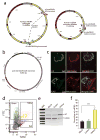Specific elimination of mutant mitochondrial genomes in patient-derived cells by mitoTALENs
- PMID: 23913125
- PMCID: PMC4153471
- DOI: 10.1038/nm.3261
Specific elimination of mutant mitochondrial genomes in patient-derived cells by mitoTALENs
Abstract
Mitochondrial diseases are commonly caused by mutated mitochondrial DNA (mtDNA), which in most cases coexists with wild-type mtDNA, resulting in mtDNA heteroplasmy. We have engineered transcription activator-like effector nucleases (TALENs) to localize to mitochondria and cleave different classes of pathogenic mtDNA mutations. Mitochondria-targeted TALEN (mitoTALEN) expression led to permanent reductions in deletion or point-mutant mtDNA in patient-derived cells, raising the possibility that these mitochondrial nucleases can be therapeutic for some mitochondrial diseases.
Figures


References
Publication types
MeSH terms
Substances
Grants and funding
LinkOut - more resources
Full Text Sources
Other Literature Sources
Medical

